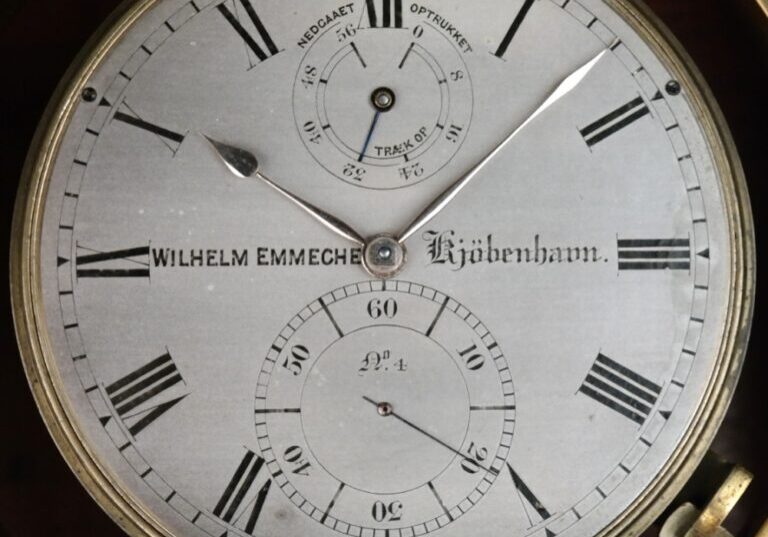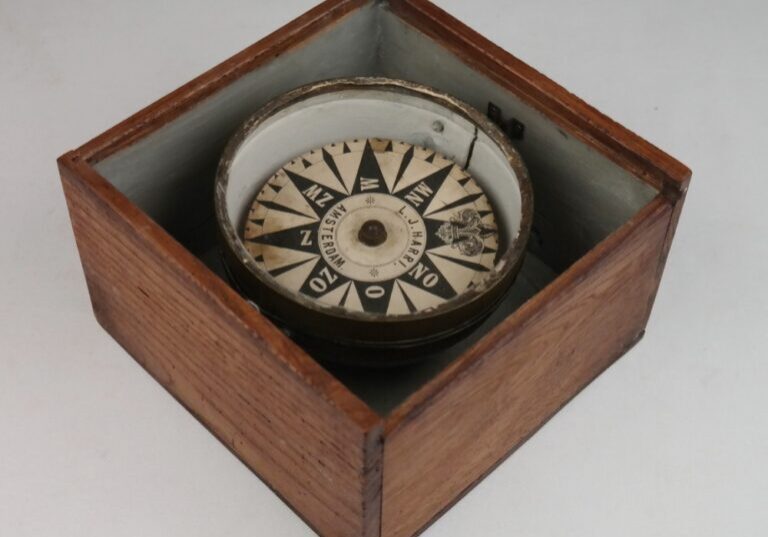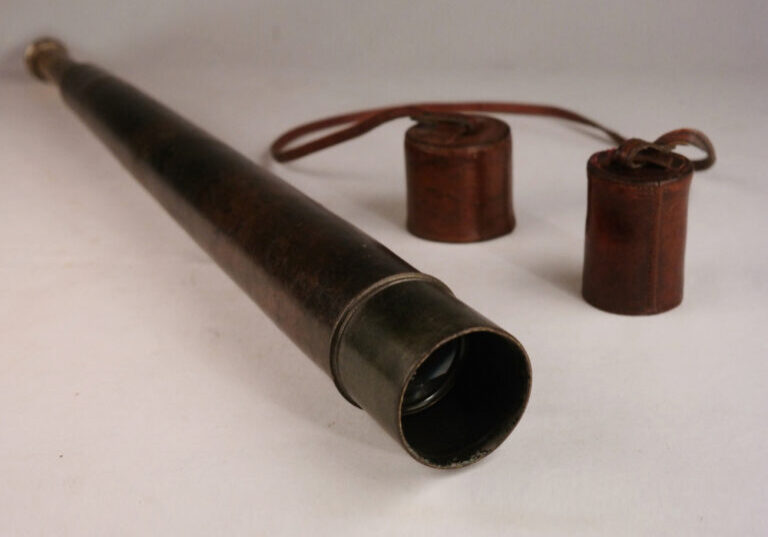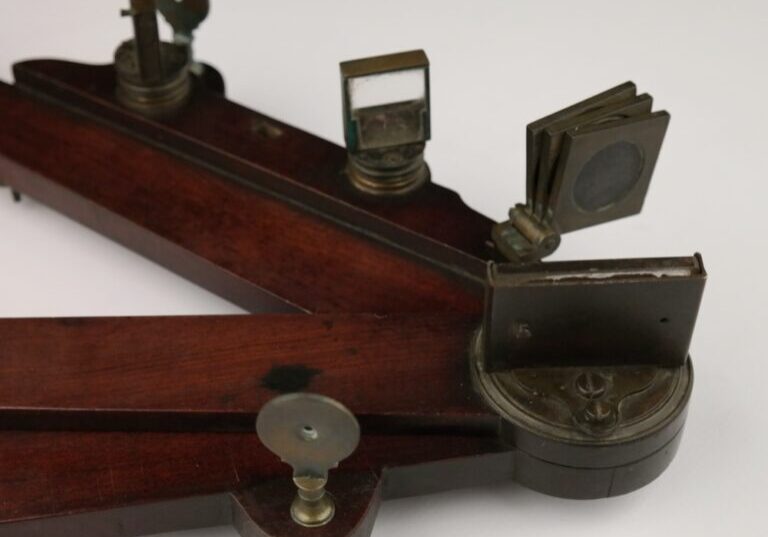Nautical instruments
This part of the collection includes mainly navigational instruments from the early sailing period, the time when ships were made of wood and men were made of steel.
Very fine and complete Brittish yacht sextant of black painted brass. In mahony case with dovetailes, lock and little key, baized-covered lid and bottom, carrying handle of brass. With silvered scale, graduated from -5 to 150 degrees, set in a brass arc.
Catalog: NM.1-12
Date: 1900-1920
HWL case: 12,8×25,5×23 cm (5x10x9,1 in)
HW sextant: 21,5×23 cm (8,4×9,1 in)
Signed: Manufactured by Heath & Co Ld Crayford, London. S.E. for J.J. Ribeiro Lisboa
Origin: England
Condition: perfect and complete
Nice quality single draw telescope with two bras tubes and good optics. Eye lens with a protective shutter. The mainbody is clad with waxed rope and in good condition. The eye lens has a sliding lens protector. The objective lens with a diameter of 55 mm (2,2”). The waxed rope barrel has taken on a nice antique patina, polished over the years.
Some signs of age and use, but with a beautiful patin, polished over the years.
The stand is new made of old oak of about the same age as the telescope.
Catalog: NM.2-29
Date: ca.1850
L: 75 cm and fully extended 104 cm (29,5 and 41”)
D objective side: 68 mm (2,7”)
Signed: P. Bassnett, Opticican, Liverpool and a trademark Try Me centred with an anchor
Origin: England
Condition: in working condition, wear consistent with age and use, shade missing
Price of the stand: E 85
A very fine two day marine chronometer made by Wilhelm Emmeche, Copenhagen, Denmark. In three-tier mahony case and a lift up glass cover. On the front an ivory nameplate and an ivory plate with No 4. No 4 is also on the dial. Hand-wound movement with power reserve of 56 hours. The movement is engraved, WILHELM EMMECHE KJÖBENHAVN No 4. With a lever for the gimbal. Beautiful patin. Good working. Both the cases and the movement are made of the finest quality. Case, chronometer and details look very similar to the chronometers made by Dent.
Catalog: NM.2-08
Date: ca. 1890-1910
HWL case: 19,2x18x18 cm (7,6×7,1×7,1”)
HWL caryingcase: 24,4×24,4×24,4 cm (9,6×9,6×9,6”)
D movement: 12,4 cm (4,9”)
Signed: WILHELM EMMECHE Kjöbenhavn
Origin: Denmark
Condition: perfect with some signs of use
Well preserved middle sized, dry card and semi gimbaled compass in painted wooden case with slit cover. On the rose with 32 points, the name of the maker. North with beautiful fleur de lis. The binnacle is made of red copper and brass. The inside of the binnacle is painted white with a lubber’s line. The case could be of a later date.
L.J. Harri sr. and jr. were compass makers in Amsterdam at the Oude Teertuinen from 1832 – 1872.
Catalog: NM.2-07
Date: ca. 1840
HWL case: 13x21x21.5 cm
D compass: 15.5 cm
Signed: L.J. HARRI. * AMSTERDAM *
Origin: Netherlands
Condition: perfect with signs of wear
Very fine and complete quartant of black painted brass. Well maintained case and instrument with key for adjusting the horizon mirror and binoculars. In mahony case with dovetailes, lock and little key, brass carrying handle an so on. Silvered scale, graduated from -5 to 185 degrees, set in a brass arc. In the brass part of the scale is engraved US NAVY N 4516. Case is also marked with the number 4516.
Made by Brandis and Sons, Brooklyn NY, instrumentmakers from 1890 till 1920.
Serialnumber of Brandis 3920 on the left side of the scale.
Catalog: NM.1-37
Date: 1900-1920
HWL case: 14×25,3×25,3 cm (4,9×10,8×10,7”)
HW quartant: 19,5×25 cm (8,5×9,2”)
Signed: BRANDIS & SONS BROOKLYN NY
Origing: USA
Condition: perfect and complete
Well preserved dry card and gimbaled compass in wooden case of oak with slit cover. On the rose with 32 points, the name of the maker. North with beautiful fleur de lis as well as the east point which indicatest the direction of Jerusalem. The inside of the binnacle is painted white with lubber’s line. On the backside of the rose a paper with Leith and three dates of control in 1860, 1861 and 1863.
Catalog: NM.1-34
Date: 1850 -1860
HWL case: 16×27,2×27,2 cm (6 2/8×10 6/8×10 6/8”)
D compass: 19,5 cm 7 6/8”)
Signed: D. STALKER * 9, COMMERCIAL PLACE, LEITH. * Quadrant Compass & Telescope Maker
Origin: England
Condition: perfect, lid seems to be of a later date
A large and very fine nautical telescope with one draw tube. Manufactured in brass with a dark brown leather clad main body and two lenscovers of brown leather. No dings or dents. Clearly signed in the draw tube. Eye lens with a protective shutter. Some signs of age and use, but with a beautiful patin, polished over the years.
Catalog: NM.2-09
Date: 1899
L, closed: 73,5 cm (29”)
L, extended: 87,5 cm (34,4”)
D, objective lens: 54 mm (2,2”)
Signed: J. HAMMERSLEY, MAKER, LONDON, 1899 AND A TRADEMARK WITH NR 248
Origin: England
Condition: for its age perfect with some minor signs of use
An interesting three mirror octant with Vernier nonius, made by or for Robert Williamson in 1768.
The first octant was created by Hadley in 1731. In Great-Britain and North-America the instrument was called the Hadley’s quadrant to distinguish it from the Davis quadrant. Hadley got in 1734 a patent for eleven years. Immediately after it came to an end other instrumentmakers started with making octants.
This octant is made of mahogany. The graduated scale is made of ivory with a Vernier nonius. The engraving is made by hand. At the graduation every degree is divided in parts of 20 minutes, The Vernier nonius is divided in twenty equal parts. The accuracy of reading with this nonius is one minute. A mistake is made on the vernier. Where 15 is engraved it should be 5.
The lower horizon mirror and peepsight were used for backward observation. As the horizon just below the sun was invisible, in this way it was possible to use the opposite horizon. The instrument was used back to front. The observer had the sun in his back. The sunshades moved to the lower position.
This beautiful instrument with nice patin, is complete and in a good condition, with three mirrors, two peep sights and two sunshades. On the backside three brass legs and the adjusting-screws.
The mirror table of this octant is also made of mahogany. Octants of a later date have brass ones. The nonius does not have a double scale anymore, but still has the width of a double scale.
Catalog: NM.2-34
Date: 1768
HW: 50×42 cm (19.8×16.5 in)
Radius (rotation axis till nonius): 43,5 cm (17.2 in)
Signed: * Robert Williamson 1768 *
Origin: England
Condition: for its age, very good, minor crack in the graduation left under, two cracks in one of the sunshades
From the 17th century onwards people had made many attempts to devise a mechanical log which would automatically record the ships distance done. Edward Massey invented a mechanical log in 1802 with four blades which was used by the Admiralty from 1807-1815.










